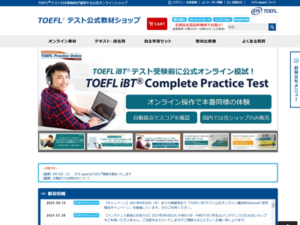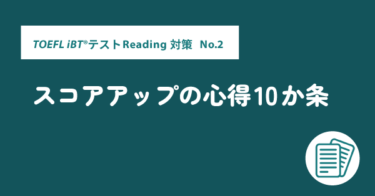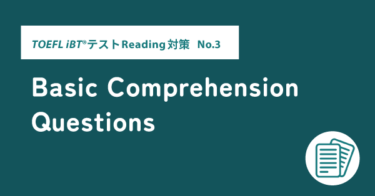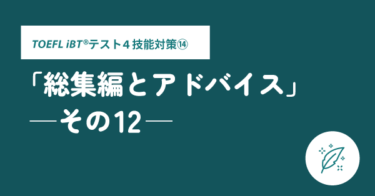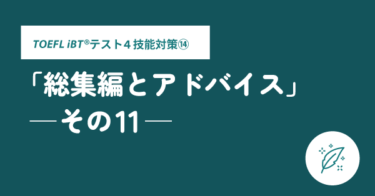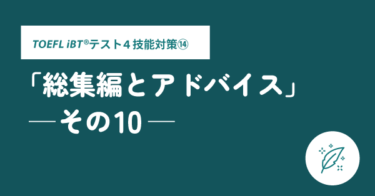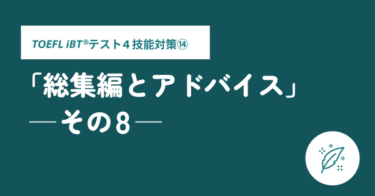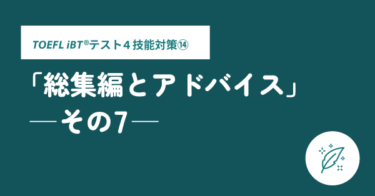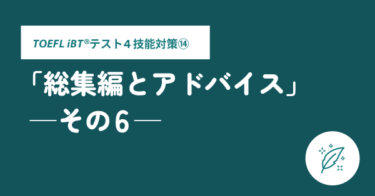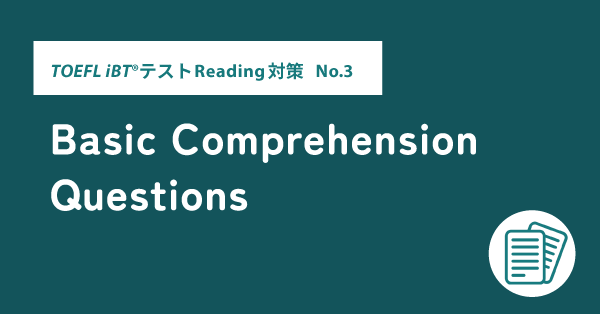
皆さんこんにちは。2月はどのように過ごされたでしょうか。大学生の方はすでに春休みに入っているかと思います。海外に旅行したり、自動車免許を取ったりなど忙しく過ごしていることでしょう。そういえば以前、大学生の教え子がCIEEの海外ボランティアプログラムを利用して休み中にアイスランドに行きました。本人曰く、当初はただ単になるべく安く海外に行ける方法を探していた、とのことですが、参加してみたら非常に有意義だったそうです。日中のボランティア活動はもちろん、夕食や夜の行動でも他の参加者との会話は全部英語で行うので、実践的な英語力がもの凄くついたと喜んでいました。あとアイスランドでは温泉をたくさん満喫できると言っていました。温泉名人(大分県別府市認定)の私としては行かないわけにはいきません!
さて今回の連載はReadingについてです。第6回Reading対策ではReadingの注意点を
皆さんこんにちは。夏の過ごし方はいかがでしょうか。私は、夏の期間中にTOEFL®テスト対策に本腰を入れてスコアを是非とも短期間で伸ばしたい!という学生達に集中講座を教える機会がありました。集中講座、というと、「い[…]
第9回Reading対策ではスコアアップの心得10か条として、Readingセクションにおける注意点やアプローチの仕方について書いてありますので、是非とも読み直してみてください。
皆さんこんにちは。すっかり寒くなってきましたね。私が今住んでいる九州の大分県では「ここは本当に九州か?」と思うほど寒くなります。特に山間部では雪がどっさり積もったり路面が凍結したりします。そういえば留学や仕事でア[…]
今回は引き続いて、さらにReadingでスコアが伸びるよう、注意点と演習を行っていきましょう。
TOEFL iBT®テストのReadingでは大きく分けて問題が3つのカテゴリに分類されます。
1)Basic Comprehension Questions
2)Inference Questions
3)Reading to Learn Questions
今日は1)Basic Comprehension Questionsを扱っていきましょう。その名の通り、「基本的な理解」を必要とする問題タイプです。すでに皆さんにとっては馴染みの深いタイプだと思いますので、それほどビックリすることはありません。またTOEFL iBT®テストをこれから受験するという人でも、以前TOEFL® PBTテスト(ペーパー版TOEFL®テスト)やTOEFL ITP®テスト(団体向けテストプログラム)を受験した経験があれば、問題なく対応できるでしょう。
Basic Comprehension Questionsには以下の問題タイプがあります。
b)Factual Information
c)Negative Factual Information
d)Sentence Simplification
このうち、d)Sentence Simplification Questionsは、やや難易度が高く、若干Inference(推測、類推)の要素が入っていることから、今回は扱わずに次回Inference Questionsの際に説明することにします。またe)Reference(代名詞)Questionsは、文中の代名詞(itやtheyなど)が指す単語を探す問題ですが、本試験ではもう出題されていないことから、ここでも扱いません。ただTOEFL ITP®テストではまだ出題されていますので、TOEFL ITP®テストも視野に入れてTOEFL iBT®テストも学習する人であれば、問題を解いて慣れておくのも良いと思います。
a)Vocabulary Questions
文字通り単語の意味を問う問題です。基礎的な単語(例:significant)の意味を問う問題もあれば、難しい内容の問題もあります。
またVocabulary Questionsは、時にはVocabulary in Contextなどとも呼ばれるように、該当する文脈に合った単語の意味を4つの選択肢の中から1つ選ぶことが要求されます。単語によっては品詞が変わることでSecondary meaningと呼ばれる、通常よく使う意味ではない方の意味で使われている場合もあります。例えば、
通常ですと「contract(名詞)=契約」の意味で使われる場合がほとんどですね。ただここでは動詞として使われています。また文脈から判断しても、
―“pull the atoms close together”(6行目~7行目)
などのヒントがありますので「contract=収縮する」とわかりますよね。ただもちろん選択肢は英語ですから「収縮する」に近い意味の選択肢を選ぶ必要がありますね。そうすると考えられるのは
― deflate
― condense
― constrict
などの類義語ですね。このような選択肢の単語にきちんとついていけますか?
ここから考えると、今後の単語学習には英和辞典でもなく英英辞典でもなく、類義語辞典が必要になってきます。類義語辞典のことを英語ではthesaurus(カタカナで敢えて書くとシソーラス)と言います。電子辞書をお持ちの方は類義語辞典の機能が付いているかもしれませんし、オンラインでも簡単に利用することができます。
b)Factual Information and
c)Negative Factual Information
「Factual=事実の、事実に基づく」という意味ですが、TOEFL®テストのReadingにおいては「本文に明確に記述されているか」を問う問題と言えましょう。逆にNegative Factualは「本文に記述がない情報」を探す問題のことです。この2つのタイプの特徴としては下記が挙げられます。
・設問文をよく読み、ヒントを得る。そのヒントを基に本文(パッセージ)から正解の根拠を探す。
・ 正解の根拠はパッセージ内の狭い範囲、通常は1センテンス内にある。
・ パッセージ中で使われている言葉は、設問や選択肢においてparaphrase(言い換え)されている場合がほとんどである。
言い換えれば「視点の狭い、詳細を問う問題」とも言えますので、Detail questionsと呼ぶ場合もあります。
1つ注意点としては、Negative Factual Questionsの場合は、記述がない「仲間はずれ」を探すことが正解につながります。すなわち選択肢4つのうち3つはパッセージ中に記述があるので「不正解」となり、残りの1つが記述がない「正解」となります。ですので、記述のある不正解の3つをパッセージ中から探す作業が必要となるため、多少時間がかかります。
ではこれらの問題タイプを演習してみましょう。第6回 TOEFL iBT® テスト Reading対策 No.1 Readingの注意点の連載で扱った物と同じ、“The Rise of Teotihuacan”のパッセージの一部、Paragraph 2~4を扱いましょう。辞書を使わずに各自で解いてみてください。
(Source = TOEFL iBT® Test Quick Prep vol. 1, Reading Practice Set 1)
How did this tremendous development take place, and why did it happen in the Teotihuacan Valley? Among the main factors are Teotihuacan’s geographic location on a natural trade route to the south and east of the Valley of Mexico, the obsidian resources in the Teotihuacan Valley itself, and the valley’s potential for extensive irrigation. The exact role of other factors is much more difficult to pinpoint—for instance, Teotihuacan’s religious significance as a shrine, the historical situation in and around the Valley of Mexico toward the end of the first millennium B.C., the ingenuity and foresightedness of Teotihuacan’s elite, and, finally, the impact of natural disasters, such as the volcanic eruptions of the late first millennium B.C.
This last factor is at least circumstantially implicated in Teotihuacan’s rise. Prior to 200 B.C., a number of relatively small centers coexisted in and near the Valley of Mexico. Around this time, the largest of these centers, Cuicuilco, was seriously affected by a volcanic eruption, with much of its agricultural land covered by lava. With Cuicuilco eliminated as a potential rival, any one of a number of relatively modest towns might have emerged as a leading economic and political power in Central Mexico. The archaeological evidence clearly indicates, though, that Teotihuacan was the center that did arise as the predominant force in the area by the first century A.D.
It seems likely that Teotihuacan’s natural resources—along with the city elite’s ability to recognize their potential—gave the city a competitive edge over its neighbors. The valley, like many other places in Mexican and Guatemalan highlands, was rich in obsidian. The hard volcanic stone was a resource that had been in great demand for many years, at least since the rise of the Olmecs (a people who flourished between 1200 and 400 B.C.), and it apparently had a secure market. Moreover, recent research on obsidian tools found at Olmec sites has shown that some of the obsidian obtained by the Olmecs originated near Teotihuacan. Teotihuacan obsidian must have been recognized as a valuable commodity for many centuries before the great city arose.
(A)identify precisely
(B)make an argument for
(C)describe
(D)understand
(A)ambition
(B)sincerity
(C)faith
(D)cleverness
(A)The presence of obsidian in the Teotihuacan Valley
(B)The potential for extensive irrigation of Teotihuacan Valley lands
(C)A long period of volcanic inactivity in the Teotihuacan Valley
(D)Teotihuacan’s location on a natural trade route
(A)most aggressive
(B)most productive
(C)principal
(D)earliest
(A)A well-exploited and readily available commodity
(B)The presence of a highly stable elite class
(C)Knowledge derived directly from the Olmecs about the art of toolmaking
(D)Scarce natural resources in nearby areas such as those located in what are now the Guatemalan and Mexican highland
いかがでしたか?解答・解説は下記をご覧ください。それでは今回はここまでにしましょう。

解答・解説(PDF:64.9 KB)
解答・解説はこちら

五十峰 聖先生
桜美林大学 芸術文化学群 特任講師
ETS Authorized Propell® Facilitator
ETS TOEFL ITP® Teacher Development Workshop Facilitator
上記は掲載時の情報です。予めご了承ください。最新情報は関連のWebページよりご確認ください。
学習サポート・関連情報
★テスト受験までの8週間サポート★

初めてTOEFL iBT®テストを受験される方のうち、次の対象者には週1回✖️8週間 の受験支援メール配信とTOEFL iBT® Test Prep Plannerの無料配送を行っています。
対策塾などに通わず、独学で勉強されている皆さん、「TOEFL®テストの勉強は孤独・心配・不安…」と感じていませんか?
ETS Japanは、8週間サポートを通じて、学習計画の立て方や、勉強に必要な情報の探し方をお手伝いします。目標スコア獲得に向けて受験日まで一緒に進んでいきましょう!
★公式教材を利用して目標スコアを目指そう★

目標スコア別に公式教材を利用した学習法を教材ショップのスタッフがご提案。学習の目安や各教材ごとの学習方法など、ぜひ参考にしてください。
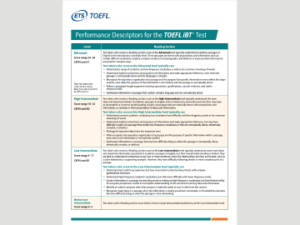
Performance Descriptors for the TOEFL iBT® test
各セクションは0~30のスコアで評価され、そのスコアに応じて4または5段階のレベルに分けられます。このレベルはTOEFL iBT®テストにおけるCEFR levelを反映しています。
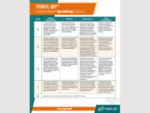
TOEFL iBT®テスト スコアガイド(Speaking)
Speakingセクションの採点基準です。上記の「Performance Descriptors for the TOEFL iBT®test」と併せてご活用ください。
SpeakingはETSが公表しているスコア基準表に沿って採点されます。採点基準はIndependent Task用・Integrated Task用にそれぞれ作成されており、Delivery(話し方)/Language Use(語彙の使い方)/Topic Development(トピックの展開)の大きく3つのポイントに分かれています。
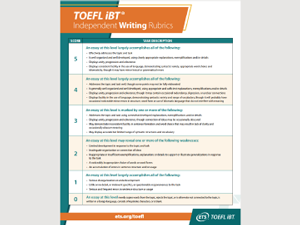
TOEFL iBT®テスト スコアガイド(Writing)
Writingセクションの採点基準です。上記の「Performance Descriptors for the TOEFL iBT® test」と併せてご活用ください。
Writingに関してもETSが公表しているスコア基準表に沿って採点されます。採点基準はIndependent Task用・Integrated Task用にそれぞれ作成されています。
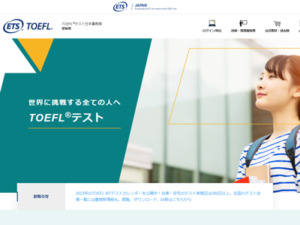
英語圏に限らず、世界の大学・大学院、その他機関で活用されています。また日本国内でも大学/大学院入試、単位認定、教員・公務員試験、国際機関の採用、自己研鑽、レベルチェック、生涯学習など活用の場は広がっています。
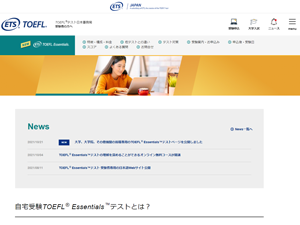
自宅受験TOEFL® Essentials™テスト
2021年から自宅受験型の新しいテストとしてリリースされました。約90分の試験時間、短い即答式タスクが特徴のアダプティブ方式の導入されています。公式スコアとして留学や就活などにご利用いただけます。
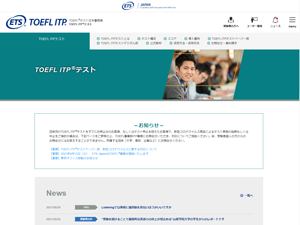
TOEFL ITP®テストプログラムは、学校・企業等でご実施いただける団体向けTOEFL®テストプログラムです。団体の都合に合わせて試験日、会場の設定を行うことができます。全国500以上の団体、約22万人以上の方々にご利用いただいています。
